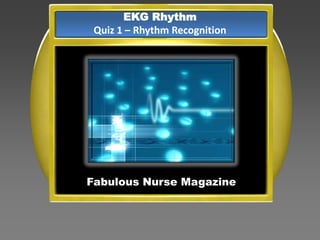
Ekg Quiz 1 Arrhythmia Recognition
- 1. EKG Rhythm Quiz 1 – Rhythm Recognition Fabulous Nurse Magazine
- 2. A Fabulous Nurse Magazine and Harrington Educational Partners Production © 2012 All Rights Reserved
- 3. EKG EKG EKG EKG EKG Rhythm 1 Rhythm 1 Rhythm 1 Rhythm 1 Rhythm 1 Recognition Recognition Recognition Recognition Recognition $100 $100 $100 $100 $100 $200 $200 $200 $200 $200 $300 $300 $300 $300 $300 $400 $400 $400 $400 $400 $500 $500 $500 $500 $500
- 4. Your patient’s HR is 60 beats/min. The rhythm is regular with one “P” wave for each “QRS.” PR interval is .18 and QRS width is .10. What is your patient’s rhythm? Return to Main Board Answer
- 5. Normal Sinus Rhythm Return to Main Board
- 6. What does a QRS >0.10 denote? Return to Main Board Answer
- 7. Bundle Branch Block Return to Main Board
- 8. This rhythm may be regular or irregular depending on conduction ratio. Hallmark sign is a pattern of multiple “sawtooth” p waves to each QRS. Return to Main Board Answer
- 9. Atrial Flutter Return to Main Board
- 10. An atrioventricular rhythm in which the PR interval progressively lengthens until QRS is dropped. Return to Main Board Answer
- 11. 2* AVB Type 1 aka Wenckebach Return to Main Board
- 12. A shockable rhythm with no well defined QRS. Totally disorganized electrical activity which may be fine or coarse. Never presents with a pulse. Return to Main Board Answer
- 13. Ventricular Fibrillation Return to Main Board
- 14. Regular rhythm. Normal QRS. One p wave per QRS. PR interval > 0.20 Return to Main Board Answer
- 15. First Degree AV Block (1* AVB) Return to Main Board
- 16. Ventricular rhythm. Wide complex QRS. Heart rate 30-40. Return to Main Board Answer
- 17. Idioventricular Rhythm (IVR) Return to Main Board
- 18. Early escape beat. Wide complex QRS. QRS unlike the rest of patient’s rhythm. Return to Main Board Answer
- 19. Premature Ventricular Contraction (PVC) Return to Main Board
- 20. Rhythm charcaterized by a total absence of ventricular activity. Return to Main Board Answer
- 21. Asystole Return to Main Board
- 22. This rhythm originates from the SA node. Is slightly irregular fluctuating with patient’s respirations. Return to Main Board Answer
- 23. Sinus Arryhthmia Return to Main Board
- 24. Irregular R-R interval. Atrial rate >350. P wave not discernible. Return to Main Board Answer
- 25. Atrial Fibrillation Return to Main Board
- 26. Originates from SA node. Regular ventricular and atrial rhythm. Heart rate < 60. Return to Main Board Answer
- 27. Sinus Bradycardia Return to Main Board
- 28. Early “P” wave followed by narrow complex QRS. PR interval normal. Return to Main Board Answer
- 29. Premature Atrial Contraction (PAC) Return to Main Board
- 30. Wide complex rhythm originating from the ventricles. Rate 140 – 200. Can present with or without a pulse. Return to Main Board Answer
- 31. Ventricular Tachycardia Return to Main Board
- 32. AV nodal rhythm. Narrow complex. PR <0.12. P wave may be inverted and/or seen after the QRS. Regular R-R HR 40-60 Return to Main Board Answer
- 33. Junctional Rhythm Return to Main Board
- 34. Spikes precede atrial and/or ventricular beats. Return to Main Board Answer
- 35. Pacemaker Rhythm Return to Main Board
- 36. AV nodal rhythm. Narrow complex. PR <0.12. P wave may be inverted and/or seen after the QRS. Regular R-R HR 60-140 Return to Main Board Answer
- 37. Accelerated Junctional Rhythm or Junctional Tachycardia Return to Main Board
- 38. Regular R-R. P waves march out. QRS may be wide or narrow. More Ps than QRSs. Return to Main Board Answer
- 39. Second Degree AV Block Type II or Mobitz II Return to Main Board
- 40. Normal QRS and PR interval. Regular ventricular and atrial rhythm. HR >100 Return to Main Board Answer
- 41. Sinus Tachycardia Return to Main Board
- 42. Originates from Atrium. Unable to measure PR interval. QRS normal. Regular atrial and ventricular rhythm. HR 150-250 Return to Main Board Answer
- 43. Atrial Tachycardia Return to Main Board
- 44. Early beat originating from the AV node. PR interval <0.12. Or no P wave before QRS. Return to Main Board Answer
- 45. Premature Junctional Contraction Return to Main Board
- 46. Organized rhythm on the monitor with no palpable pulse. Return to Main Board Answer
- 47. Pulseless Electrical Activity (PEA) Return to Main Board
- 48. Ventricular rhythm. Wide complex QRS. Heart rate 60-100. Return to Main Board Answer
- 49. Accelerated Idioventricular Rhythm Return to Main Board
- 50. SA node ceases to pace. An automaticity focus escapes to become the permanent pacer maintaining patient’s inherent rate. Return to Main Board Answer
- 51. Sinus Arrest Return to Main Board
- 52. Total block of conduction to the ventricles. P waves have no relationship to QRS. Ventricular rate usually < 40. Return to Main Board Answer
- 53. Complete Heart Block (3* AVB) Return to Main Board
- 54. To play more games and try other fun learning tools visit the Fabulous Nurse Magazine website. Fabulous Nurse Magazine www.fabulousnurse.com © 2012 All Rights Reserved
- 55. Fabulous Nurse Magazine www.fabulousnurse.com © 2012 All Rights Reserved
